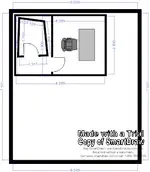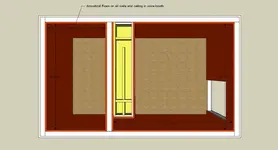J
jinglesmountjoy
New member
Hi all...This would my first offical post.
I'm in the fortunate position of building my studio from the ground up but want to avoid soundproofing overkill. It'll be used for voice work so keeping sound out is my only concern (rather than keeping it in).
I live in a small town in the Niagara region of Ontario, Canada and the biggest noise concern would be the odd Harley/ATV driving by at an inopportune time.
I've attached a drawing of what I'll call, "plan A"...sorry, but the measurements in the drawing are metric.
The largest room is obviously the garage - 23'x20' & about 11' feet high and all walls finished with drywall.
The rectangular structure at top left is "the studio" - roughly 9'x14'
Within the studio...the control room (right) & isolated voice booth (left)
I had intended on using QuietRock 510 but after doing a search on this forum and reading through the threads that came up, I've decided against it. So this is what I'm thinking...
"The Studio" will be built using standard 2x4 wall construction with a layer of 5/8" followed by 1/2", both on the garage side only and insulation called "Roxul Safe 'N' Sound" between studs.
Inside, the control room will also have a layer of 5/8" and a layer of 1/2" but in the room housing the voice booth, I will simpy cover the insulated stud wall with fabric.
The voice booth will also be of standard 2x4 construction but the outside surface will have NO drywall followed by the same Roxul insulation between the studs and finally on the inner surface, the same 5/8" and 1/2" layers.
My thoughts on the ceilings are exactly the same construction with the ceiling over the control room having the double drywall treatment and over the voice booth having the insulation/cloth treatment.
The voice booth would also have it's own ceiling with double drywall on inside and of course...fabric on outer surface.
Obviously, without being here, it's hard to give your opinion but I'm looking to get everyone's thoughts. Do you think it's enough?
Appologies for the lengthy post.
I'm in the fortunate position of building my studio from the ground up but want to avoid soundproofing overkill. It'll be used for voice work so keeping sound out is my only concern (rather than keeping it in).
I live in a small town in the Niagara region of Ontario, Canada and the biggest noise concern would be the odd Harley/ATV driving by at an inopportune time.
I've attached a drawing of what I'll call, "plan A"...sorry, but the measurements in the drawing are metric.
The largest room is obviously the garage - 23'x20' & about 11' feet high and all walls finished with drywall.
The rectangular structure at top left is "the studio" - roughly 9'x14'
Within the studio...the control room (right) & isolated voice booth (left)
I had intended on using QuietRock 510 but after doing a search on this forum and reading through the threads that came up, I've decided against it. So this is what I'm thinking...
"The Studio" will be built using standard 2x4 wall construction with a layer of 5/8" followed by 1/2", both on the garage side only and insulation called "Roxul Safe 'N' Sound" between studs.
Inside, the control room will also have a layer of 5/8" and a layer of 1/2" but in the room housing the voice booth, I will simpy cover the insulated stud wall with fabric.
The voice booth will also be of standard 2x4 construction but the outside surface will have NO drywall followed by the same Roxul insulation between the studs and finally on the inner surface, the same 5/8" and 1/2" layers.
My thoughts on the ceilings are exactly the same construction with the ceiling over the control room having the double drywall treatment and over the voice booth having the insulation/cloth treatment.
The voice booth would also have it's own ceiling with double drywall on inside and of course...fabric on outer surface.
Obviously, without being here, it's hard to give your opinion but I'm looking to get everyone's thoughts. Do you think it's enough?
Appologies for the lengthy post.




 You know your stuff.
You know your stuff.
 It cracks me up. I kind of like it!
It cracks me up. I kind of like it! Another thing. After viewing you pdf., something tells me this "booth" won't pass inspection, because of the sheer minimum depth of the room at 3.5 feet. I could be wrong, but HABITABLE space usually is defined by CODE with minimum dimensions. I'd check with your Building inspection Dept. on this. Not only that, but I would suggest using Resiliant Channel for this space instead of building a double wall setup. Looks like a LOT of work for a VERY SMALL room. Ever stood in a closet? By the time you put in enough absorption to make it work, you won't be able to turn around. Sometimes things on paper give NO scale to actual space.
Another thing. After viewing you pdf., something tells me this "booth" won't pass inspection, because of the sheer minimum depth of the room at 3.5 feet. I could be wrong, but HABITABLE space usually is defined by CODE with minimum dimensions. I'd check with your Building inspection Dept. on this. Not only that, but I would suggest using Resiliant Channel for this space instead of building a double wall setup. Looks like a LOT of work for a VERY SMALL room. Ever stood in a closet? By the time you put in enough absorption to make it work, you won't be able to turn around. Sometimes things on paper give NO scale to actual space. . Do you know of any sources where I might be able to research decible blockage of various materials/methods so as to ascertain exactly what I might expect to block out with various building methods/materials?
. Do you know of any sources where I might be able to research decible blockage of various materials/methods so as to ascertain exactly what I might expect to block out with various building methods/materials?